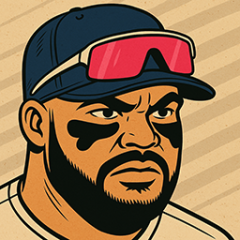-
Posts
8108 -
Joined
-
Days Won
42
Content Type
Profiles
Forums
Downloads
Everything posted by Kccitystar
-

Running MVP 2005 doesn't work in Virtualized Windows XP environment
Kccitystar replied to DougFromLI's topic in Support
Ubuntu images are easy to grab (yay for open source) but a Windows 7 iso may be tricky these days.- 19 replies
-
- virtualbox
- cd
-
(and 1 more)
Tagged with:
-

Running MVP 2005 doesn't work in Virtualized Windows XP environment
Kccitystar replied to DougFromLI's topic in Support
No that's what I meant, virtualize Ubuntu instead and give that a shot, or Windows 7 instead of XP SP3- 19 replies
-
- virtualbox
- cd
-
(and 1 more)
Tagged with:
-

Running MVP 2005 doesn't work in Virtualized Windows XP environment
Kccitystar replied to DougFromLI's topic in Support
You would have better luck running MVP 2005 on Ubuntu using WINE than a virtualized instance of Windows XP, I feel.- 19 replies
-
- virtualbox
- cd
-
(and 1 more)
Tagged with:
-
Vibration doesn't work because the 360 controller, or even most modern controllers now use a completely different type of input (XInput) from what existed at the time on PC (DInput). The controller being able to work itself is a complete hack of the controller.cfg file.
-

looking to accquire mvp baseball 2005 pc cd
Kccitystar replied to ikz's topic in Left Field (Off-Topic)
I should double check my copy. I haven't played MVP in years, because I think my Disc 2 is cracked. Or maybe it was Disc 1..... -
The stuff I need to catch up on while I'm offline, holy hell. Glad to see you back on Y4L. Just try to take things easy at least for this season!
-
I think the glasses were intended for Eric Gagne on the stock roster
-
I don't know what game this is referring to since you posted this on the mvpmods.com category
-
This has gotten flagged as a virus by a handful of members of the community both publicly and in DMs so I will not vouch for this solution in the meantime. From my understanding, basically instead of a cracked executable, this spoofs the SafeDisc driver on Windows 10/11 so MVP can validate the disc check. The game would eventually load and work like it used to on Windows 7 and XP. This solution might work but is not one I'd recommend given that it includes DLLs that might flag your machine's AV for suspicious behavior. Sometimes, it isn't the files themselves that are bad, but the mechanisms the files in the utility uses that fit the profile of a virus or malware that flag your AV as being suspicious. It's why we took Reditor II down. Pretty much, the utility itself was a freemium app from the start, and it was designed with a mechanism that would phone home back to the author's server to validate a key if you had paid for the app. Since that's a vector for potentially trojan horsing a virus or something bad, any AV app flags it as malware now. It was converted into a free app as part of the last update for it, but the mechanism was never removed. The existing crack for MVP is just for the launch copy, stutters and bugs and all, but the longshot solution for a lot of people is to have someone crack the Patch 5 executable and I will hold hope until that day comes.
-
Un-archived the thread as there is revived interest in the project. Play ball!
-
I'll tell you why Boone is unlikely to be fired every postseason exit, and this is just my hot take: Aaron Boone is just following the organizational philosophy to the letter. The org/analytics team have their processes, their "lanes", and their "systems". The problem and flaw with this philosophy is that these things are way too rigid for baseball, and the organization has shown time and time again that they are not willing to adapt to real-time variables, or as people say, the intangibles. The Yankees’ system is designed to minimize the impact of human intuition and natural player instincts in favor of a process that can be consistently defended by numbers that you can repeat and get the same result every time. The problem is that refusal to account for these real-time variables means that the team is frequently blindsided when situations do not unfold as projected by the data. If you view team decisions and situations through a "process" lens, you can become just as detached from reality as Cashman. The entire view of the organization is that as long as that game decision that you made was driven by the analytics and data that you had, or that we (as the organization) gave you, then the outcome is just the outcome, and not just the result of a "mistake" that you made. It's easier to defend failures as "bad luck" or "outliers", rather than as signals that the process that got you to that result might need a significant overhaul. It's how EVERYONE avoids accountability up and down the organization. Throughout the years seeing the Boone-era Yanks play, my newfound understanding of how heavy-handed the organization's data driven approach was made every baffling Boone decision click for me. A great example is how Boone handles slumping players. A data-driven perspective might show that in the long run, a specific player is expected to rebound based on historical averages and underlying metrics. Even though this can be true, it doesn't look at immediate factors like fatigue, psychological struggles, or adjustments opponents have made that require timely, human intervention. The rigidity to “trust the process” means these nuances are ignored, and decisions that should be flexible become formulaic. All of these things require some level of situational awareness, as they have always been factors that play into the outcome of the games. The worst part about this philosophy is how it allows both Boone and Cashman to deflect blame. When decisions don’t lead to wins, they can be justified by pointing to the data that informed them. This shields Boone from criticism since he’s merely executing a plan based on data, and it insulates the front office by framing failures as outliers or the result of bad luck. This cycle of justifying losses with analytics and variance discourages the organization to look introspectively at what they are doing wrong. They never reach a point where they question whether the overarching strategy is flawed; instead, they simply tweak the process without re-examining its premise. If you look at how the Yankees lost Game 1 of the World Series, following it through as a series of "processes" and "lanes", it looks completely defensible on paper because the data says so/suggests as such. In actual reality it ignored literally all of the game context any manager who still had a feel for the game would have adapted to: Taking Cole out early. This was probably driven by pitch counts and matchup data. On paper, it sounds like the best move, but in doing so, it ignores literally all of the on-field stuff you see as a manager, like the flow of the game. You can see that Cole has momentum. You can see that he isn't tired and that he's locked in on the mound. He says he feels great. The Dodgers aren't hitting him as hard. By being so rigid with processes and not willing to adapt to what you see on the field, you disrupt all of the momentum Cole had all game, and your decision is going to put pressure on the bullpen to perform to get 9 high-leverage outs. Using Cortes, who did not pitch off a mound since September 18, again, driven by the data regarding his good numbers against lefties. It ended up giving the Dodgers the game. It ignored every real-time variable, like the long layoff, the fact that it was a high leverage situation, and the fact that Tim Hill was probably your most effective lefthander in the bullpen throughout the playoffs. Defensive alignments: They're all influenced by data and analytics that tell you where you should stand on the field based on batted ball data and the hitter's tendencies. If you rely solely on that data, you're not taking into account game momentum, or how a team is approaching their at-bats for that situation or for that specific game, or how likely a player's hitting tendencies might not align with aggregated data. Now you have players thinking too much on where they "should" be on the field and not using their situational awareness to respond naturally to a play as it unfolds. The worst part about all of this is that the Yankees would never consider the overall philosophy as systemically not effective. Teams that consistently contend for championships don’t abandon analytics but instead use them as part of a holistic strategy that considers the human side of the game. The Yankees’ unwillingness to adapt to real-time variables or acknowledge that their process might need a fundamental change is why we keep having early exits in the playoffs when we're able to contend. As long as Boone follows the process, his job is safe, and the organization won’t consider these failures as reflective of deeper issues within their strategic approach.
-
Set the refresh rate to 60 if you have vsync enabled. I think the game doesn't play nice with high refresh rate displays
-

Editing Rosters through REDitor: A Research Thread
Kccitystar replied to Kccitystar's topic in Mod Research
There's additional properties to each slot that isn't accounted for in Vlad's editor, like Inside Edge data, hot/cold zones, etc but REDitor was never really developed further for MLB 2K12 -

Editing Rosters through REDitor: A Research Thread
Kccitystar replied to Kccitystar's topic in Mod Research
I mean the existing values can be tested, sure, but the dif values for the revamped pitches haven't been adjusted. After adjusting the Dif values, a roster maker would just need to re-calculate every pitcher's pitch rating in the game to accomodate the changes since it would change the weight of each rating and affect CPU behavior -

Editing Rosters through REDitor: A Research Thread
Kccitystar replied to Kccitystar's topic in Mod Research
WacoKid and I spent some time working on these new pitch shapes. For these demos, my pitcher, Firstman Lastings, has his arsenal set to their maximum OVR so these are all considered "elite" pitches by the game. I've also adjusted the difficulty slider for Pitch Speed to 100 so you can see the movement in the game's concept of "real world speed". Circle Changeup - We adjusted the trajectory values so there's some fade and the DownImp values were adjusted so there's some downward force applied to the pitch, but not as drastic. Very Devin Williams-esque. Looks phenomenal. Changeup, with fastball followup. The changeup has less drop than the circle change, and the fastball was tweaked slightly to have some small arm-side deviation so it doesn't appear to be laser straight. The speed differences are absurd for someone who clocks their fastball at 104. Sinker with arm-side fade. Jordan Hicks style movement is possible! Two-Seam Fastball - Even though it can be often interchangeable with the Sinker these days in MLB, we wanted to give it some more lateral run like a traditional two-seamer but it's adjusted enough to break late. Looks good. I revamped the cut fastball and it looks absolutely devastating. Mariano Rivera would be proud. Lastly, we spent some time looking at developing a pitch that doesn't exist in the game, the Sweeper. The idea was to have its movement somewhere in between the curveballs in the game and the slider (which is what it is in real life), and I think we got there. While we can't add pitches, I wanted to experiment so I swapped out the values of the Eephus pitch with what a sweeper would look like. Ian Kinsler never stood a chance. Would love to hear some feedback! -

Editing Rosters through REDitor: A Research Thread
Kccitystar replied to Kccitystar's topic in Mod Research
The Astros being visible in the AL West column is related to changes to your roster, not through the IFF you're looking to modify -

Editing Rosters through REDitor: A Research Thread
Kccitystar replied to Kccitystar's topic in Mod Research
Interesting. I'll continue to tinker with this -

Editing Rosters through REDitor: A Research Thread
Kccitystar replied to Kccitystar's topic in Mod Research
So about those Dif values for each pitch...: The DifVeloc, DifUnexp, and DifTraj values are used in combination to contribute to a 100-point scale that determines a pitch's overall rating in the game, and they correlate directly with a player's attributes for speed, movement, and control. The values act as weights for each attribute in calculating the pitch's effectiveness. In this system, the Dif values would effectively scale a pitcher's individual attributes against a league average to determine the pitch's overall rating. This would mean that adjustments to the Dif values need to be made with careful consideration of how they would affect the weighting of each attribute in the overall calculation. Let's take Clayton Kershaw's slider as an example: If his slider attributes are 86 speed, 99 movement, and 98 control, and we're using the DifVeloc, DifUnexp, and DifTraj values as weights, the calculation for the overall rating of a pitch, like the slider in this case, would be something like this: Pitch OVR = (Speed * DifVeloc) + (Movement * DifUnexp) + (Control * DifTraj) Those three values are meant to help the game calculate dominant pitches from individual players. -

Editing Rosters through REDitor: A Research Thread
Kccitystar replied to Kccitystar's topic in Mod Research
I'll DM you with the revised pitch values for you guys to test -

Editing Rosters through REDitor: A Research Thread
Kccitystar replied to Kccitystar's topic in Mod Research
Tinkering with this tonight, specifically tinkering with the properties of the default slider. I've set the difficulty sliders to 50 which is baseline (or the "Pro" difficulty setting) I chose the slider for two key reasons: If I'm trying to figure out if the wind settings play a factor with pitch movement, the lateral movement a slider has is clearly visible If I'm tinkering with trajectory and lateral movement, I can see that too. Here's the default behavior of the slider. Kershaw has the most elite slider in the game, so thats' who I used to test the pitch. Additionally, the location is static. Just a max-ed out slider down the middle. This guarantees I'm going to have the pitch land in the same spot every time. Here's the modified slider with all of the values adjusted on the right side of the screen. Looks like it's got more bite than the default pitch characteristics! Here's the more complete, final overhaul of the slider with every adjusted value on the side. Can't wait to see what a revamped fastball looks like in the game! -

Editing Rosters through REDitor: A Research Thread
Kccitystar replied to Kccitystar's topic in Mod Research
the sweet sweet art of pitch physics my friend -

Editing Rosters through REDitor: A Research Thread
Kccitystar replied to Kccitystar's topic in Mod Research
Pitches Tab: Took a while but I was able to understand what these values were that we were so stumped on for some time that weren't explained completely through Vlad's documentation for REDitor, like these values: DownImp1 DownImp2 Param4 DifVeloc DifUnexp DifTraj Since they're shorthand names for global pitch attributes/characteristics, this is kind of what I've been able to breakdown, and I may be wrong to an extent. I will note that sliders in the game can impact pitch characteristics and how the CPU behaves: DownImp1 and 2 might represent two different aspects of the downward impulse applied to the pitch. This could relate to how the pitch's speed or trajectory is affected by gravity or the pitcher's motion over two different phases of the pitch's flight (initial release from the hand vs arrival to home plate) HorizImp would suggests Horizontal Impulse, which would affect the pitch's movement left or right. This could be a measure of the pitch's ability to break or move horizontally, influenced by the spin and the angle of the pitch as released by the pitcher. For a curveball, sinker or a slider, a higher value might indicate a greater break. The default is 0 for these pitches. Param4 was the big one I was trying to figure out, but because it only has decimal values going from 0.5 to 0.8, it's probably a coefficient related to one of the pitch attributes, so I'm going to tinker with this a bit DifVeloc, DifUnexp, DifTraj (or as I call them, "The Dif's") are meant to simulate the dynamics of facing different pitch types from the perspective of the hitter/cpu and it's scaled from 0.0 to 1. I'll use the fastball in the game as a baseline: DifVeloc would represent how difficult a pitch is to hit because of the velocity variation (difference between MinSpeed and MaxSpeed). A value scaling up from 0.0 to 1 affects how hard it is for you or the CPU to time a fast pitch. So if a pitch has a 0 value, there's no additional challenge from velocity variation, but if a pitch has a 1 value it's extremely hard to get solid contact on a pitch. The pitch speed is predictable or doesn't significantly impact how you can time the pitch. A fastball has a default value of 0.5 for example, so it's still challenging to time but you're able to square it up. DifUnexp might represent how difficult a pitch is to hit due to unpredictability in when you or the CPU are sitting on one. A value scaling from 0.0 to 1 would affect how predictable the pitch is for you or the CPU to anticipate. So a value of 0.0 means the pitch is easy to read or anticipate in a certain count, but if a pitch has a 1 value it means it's extremely unpredictable, so either the pitch is not often used, it moves closely to another pitch until it's final approach to the plate or its movement can fool you. A fastball has a default value of 0.5, for example, so it might be used in certain counts or it's deceptive enough to make you or the CPU lookout for one. DifTraj might represent difficulty due to trajectory, so a value scaling from 0.0 to 1 means a pitch might be hard to hit based on how clear the pitch's path is to you or the CPU. So a pitch with a 0.0 value would mean it's a completely flat pitch or its movement is predictable for you or the CPU, but if a pitch has a value of 1, it means that the pitch's trajectory is challenging, either there's significant break, drop, or unexpected movement that you or the CPU need to adjust to. A fastball has a default value of 0, for example, so you would only need to worry more about timing and speed of the pitch. Let's use the baseline Dif values of a fastball (0.5, 0.5, 0) and compare that to two other pitches, a 2-seam fastball, and a Curveball. It's an example of a pitch that doesn't deviate much from the in-game fastball vs a pitch with completely different characteristics. Compared to the fastball, the 2-seam fastball's Dif values have a slightly higher variance from the fastball (0.4, 0.4, 0.2). What does that mean for you? This means that you or the CPU can anticipate and adjust to 2-seamers but the DifTraj being 0.2 means it's more challenging to hit it squarely. Which 2K attempted to have reflect real life, because two-seamers have different degrees (default is 260 for the game's 2FB) of armside fadeaway so they induce grounders, like sinkers. A Curveball in the game has Dif values of (0.05, 0.5 and 0.45). What does that mean for you? It means that it's not hard to time (DifVeloc) but it's speed is fairly consistent. It's got the same level of unpredictability as a fastball (a value of 0.5 means that it can surprise you in any count, and there's a 50/50 chance the CPU will take the pitch), but the high DifTraj value (0.45) means that it's much harder for you or the CPU to hit because of the big break (default is 150 for the curveball). -

Editing Rosters through REDitor: A Research Thread
Kccitystar replied to Kccitystar's topic in Mod Research
I was researching how to accurately build out a physics system within Unity for a baseball sim, and it led me to look into MLB2K12 regarding specific attributes from that Pitches tab on REDitor -

Editing Rosters through REDitor: A Research Thread
Kccitystar replied to Kccitystar's topic in Mod Research
wake up gang, there's work to do thanks to chatgpt -
This is fine, these are all AAAA fringe guys


